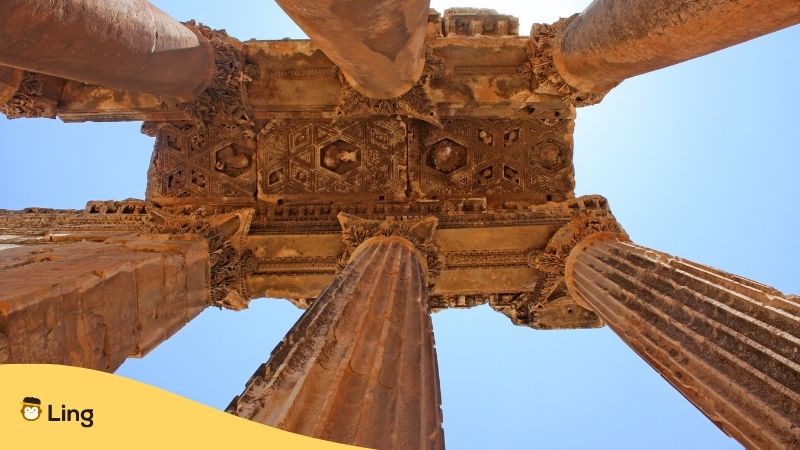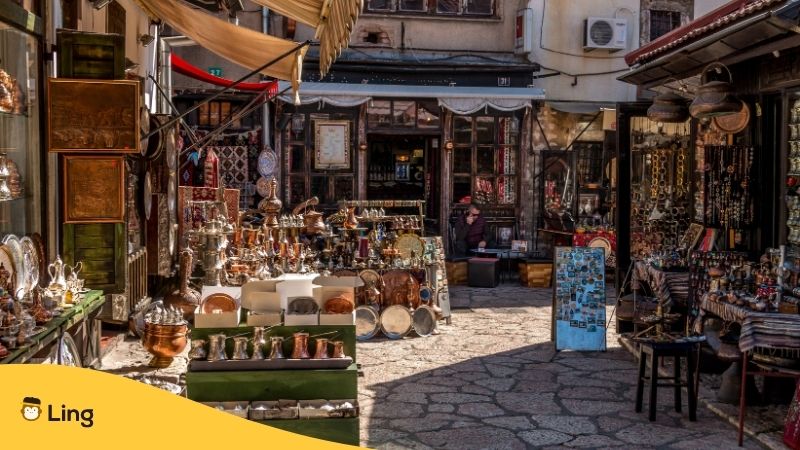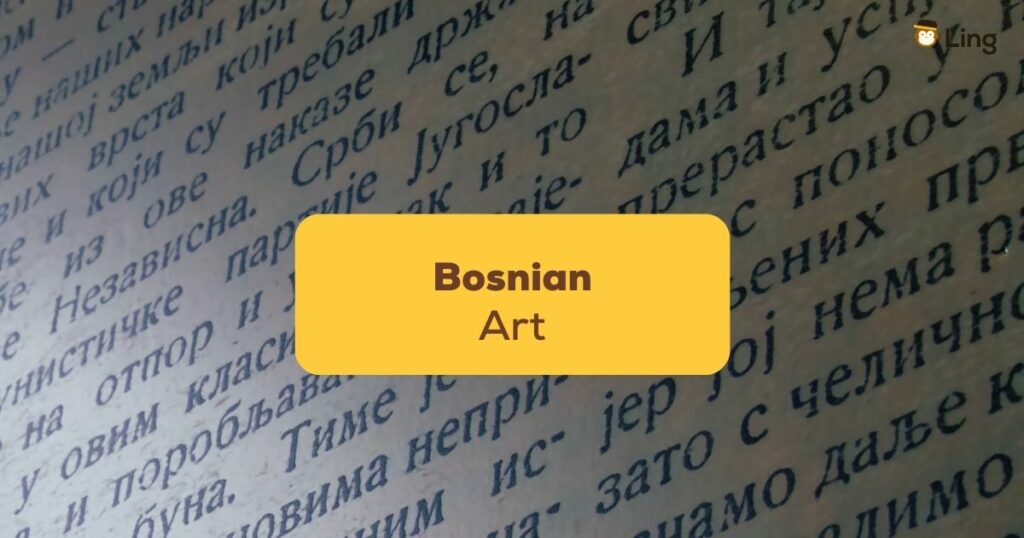Bosnia is not necessarily a country we all immediately associate with high art. In today’s post, we’ll review why its selection of rich art forms is also worth the hype. In addition, we rounded up the best Bosnian art terminologies for you to know, especially if you want to speak with the locals. Let’s begin!
Bosnian Art Through The Years
The Stone Age
The art of Bosnia and Herzegovina dates back to the Stone Age. Deep in Badanj Cave is a fine example of paleolithic carving dating between 14000 and 12000 BC. The Horse Attacked by Arrows is the most famous of the engravings and depicts, as its title implies, a horse attacked by arrows fired at it.
Bronze Age
Stone and Copper Age art in Herzegovina was heavily influenced by wares coming from the Western Mediterranean. Adriatic cultures also influenced the pottery produced on the Bosna River’s upper reaches. Some fine examples of ceramics with four legs and drinking vessels known as Rhyton have been discovered on the nearby Croatia coast.
Iron Age
Iron began to replace bronze around the 7th century BC. At his time, the Illyrians came together in Bosnia and Herzegovina, Serbia, and Croatia. However, little remains of their settlements, and metal and stone implements, have been buried with urns and skeletons. The Japodian tribes who settled around the Bosnian administrative center of Bihać were creating heavy necklaces from white, blue, and yellow glass paste.
Bronze was being used to forge diadems, spiral bracelets, and helmets. Although their influence was limited in Bosnian and Herzegovinan art, the Celts brought the pottery wheel with them when they came to the region in the 4th Century BC.
Bosnian Art In Antiquity
The Illyrian provinces were brought under the yoke of the Roman Empire in the first century BC. Bosnia had rich mineral deposits, especially silver, which attracted the Romans, who erected several temples in the area decorated with sculptures and reliefs. Bosnian art, at this time, mainly consisted of basilicas, mausoleums, oratories, and statues.

Medieval Artistic Influences
The 14th century saw the introduction of Gothic artistic influences as a knightly culture and religion dominated Bosnian society. Massive tombstones have always marked the Bosnian nobility’s last resting places, and many of these were erected at the sides of roads. The stones were engraved with symbols and motifs, often with Bosnian Cyrillic texts. Roman influence can be seen in semi-circular arches, arcades, crosses, and half-moon shapes. The western European Celtic influence is evident in carvings representing lilies, swords, shields, knights, and hooks.
The illuminated manuscripts are probably the most vivid representations of the medieval artistic period in Bosnia. Hval’s missionary is a book containing numerous colorful imagery, and Misal Hrvoja Vukčića Hrvatinića is a brightly colored manuscript that celebrates the notions of chivalry and is commissioned by the Grand Duke of Bosnia, Hrvoje Vukčić Hrvatinić.
Want to learn further how others influenced Bosnian art? Check out the sections below!
Bosnian Art Under The Ottomans
We were now in the 16th century, and Bosnia and Herzegovina was part of the Ottoman Empire. Islamic art replaced the influences from Western Europe and remained the primary influence until the 19th century. The town of Foča in the southeast of the region saw no fewer than six public baths, 29 public fountains, and 17 mosques erected in the 16th century under the cultural influence of the Ottomans. Islamic calligraphy and Persian painting decorated the numerous Islamic manuscripts in the region’s libraries today.
The Sarajevo Haggadah, dating to the 14th century, remained one of the most important illuminated manuscripts and was brought to Bosnia by Jewish refugees expelled from Spain. Valued at a price of around seven million dollars, the manuscript is currently housed in Sarajevo’s National Museum of Bosnia and Herzegovina. Many brightly colored illustrations feature wine stains, testimony to the many Passover Seders in which the book has been used. Because they represent the link between the earthly realm and heaven, bridges are important in Islamic art. The most well-known is Mostar’s Old Bridge.
Austro-Hungarian Artistic Influences
Under the Austro-Hungarians, Bosnian art took on a distinctly neo-gothic, neo-classical, neo-renaissance, and neo-baroque feel. The pseudo-Moorish style also came in from Egypt and Southern Spain. The Mostar Gymnasium, National Library, and City Hall in Sarajevo are superb examples of this type of architecture.
Yugoslavian Art In Bosnia And Herzegovina
The end of World War I saw a blossoming of art in Bosnia, including art gatherings and art exhibitions. Abstract paintings were being created by artists including Jovan Bijelić and
Roman Petrović. Color landscapes were being painted by artists such as Karlo Mijić. Although the regions suffered an exodus of artists who left to study in other cities, art movements such as the “Group of Four,” “The Children of the Street,” and “The Circle” represented a renewal in the 1930s.
Following the end of World War II and the founding of Communist Yugoslavia, artists began to use the ideas of war and revolution in their paintings and sculptures. Branko Šotra and Ismet Mujezinović were leaders in the movement. By the 1950s, art was taking on a more abstract look. The Communist regime was commissioning large abstract sculptures, and industrial monuments were being built to celebrate famous victories during the war. During the 1960s and 1970s, artists such as Mehmed Zaimović and Dževad Hozo started turning the traditional Bosnian culture for ideas.

The Influence Of The Bosnian War And Its Aftermath
A spate of rebuilding following the destruction of buildings during the war has resulted in the construction of impressive structures, including the Unis Twin Towers, the Bosmal City Centre, and the Avaz Twist Tower, now Bosnia and Herzegovina’s tallest tower.
Essential Art Words In Bosnian
Are you planning to travel to Bosnia and Herzegovina? Use these epic words to make your conversation with the locals extra meaningful!
| English | Bosnian |
| Art | Art |
| Artist | Umjetnik |
| Drawing | Crtanje |
| Illustration | Ilustracija |
| Painting | Slikarstvo |
| Painter | Slikar |
| Sculpture | Sculpture |
| Sketch | Skica |
| Watercolour | Akvarel |
Learn Bosnian With Ling!

Learning some basic Bosnian is a great way to learn more about Bosnian art. Our advice? Learn with the Ling app, as it provides easy and fun ways to get to grips with Bosnian in fun and engaging way. The app uses quizzes and games to help make learning a new language more interesting! Want to try it out? Download the Ling app today at Google Play and App Store.



































































